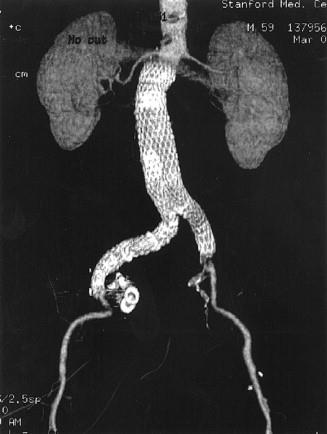Outcome after unilateral hypogastric artery occlusion during endovascular aneurysm repair |
| |
| Authors: | Lee W A O'Dorisio J Wolf Y G Hill B B Fogarty T J Zarins C K |
| |
| Affiliation: | Division of Vascular Surgery, Stanford University, CA, USA. |
| |
| Abstract: | 
PURPOSE: The purpose of this study was to determine the long-term functional outcome after unilateral hypogastric artery occlusion during endovascular stent graft repair of aortoiliac aneurysms. METHODS: During a 41-month period, 157 consecutive patients underwent elective endovascular stent graft repair of aortoiliac aneurysms with the Medtronic AneuRx device. Postoperative computed tomography scans were compared with preoperative scans to identify new hypogastric artery occlusions. Twenty-three (15%) patients had unilateral hypogastric occlusion, and there were no cases of bilateral occlusions. Telephone interviews about past and current levels of activity and symptoms were conducted, and pertinent medical records were reviewed. All 23 (100%) patients were available for the telephone interview. A disability score (DS) was quantitatively graded on a discrete scale ranging from 0 to 10 corresponding to "virtually bed-bound" to "greater-than-a-mile" exercise tolerance. Worsening or improvement of symptoms was expressed as a difference in DS between two time points (-, worsening/+, improving). RESULTS: Among the 23 patients, two groups were identified: 10 patients (43%) had planned and 13 patients (57%) had unplanned or inadvertent occlusions. The patients in the two groups did not differ significantly in the mean age (73.4 vs 73.7 years), sex (male:female, 9:1 vs 10:3), and duration of follow-up (15.6 vs 14.4 months). Nine (39%) of the 23 patients, five patients in the planned and four patients in the unplanned group, reported significant symptoms of hip and buttock claudication ipsilateral to their occluded hypogastric arteries. The mean decrement from baseline of these nine patients in their DS postoperatively was -3.3. The symptoms were universally noted on postoperative day 1. Although most patients improved (89%), one (11%) never got better. Among those whose symptoms improved, the mean time to improvement was 15 weeks, but with a plateau thereafter resulting in a net decrement of DS of -2.3 from baseline. Finally, when questioned whether they would undergo the procedure again, all 23 patients unanimously answered, "Yes." CONCLUSIONS: A significant number (39%) of patients who sustain hypogastric artery occlusion after endovascular aneurysm repair have symptoms. Although most patients with symptoms have some improvement, none return to their baseline level of activity. Despite this, all patients in retrospect would again choose endovascular repair over conventional open repair. |
| |
| Keywords: | |
| 本文献已被 ScienceDirect PubMed 等数据库收录! |
|

